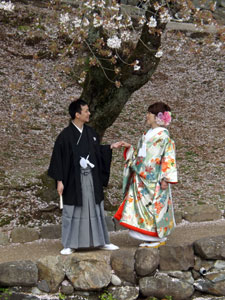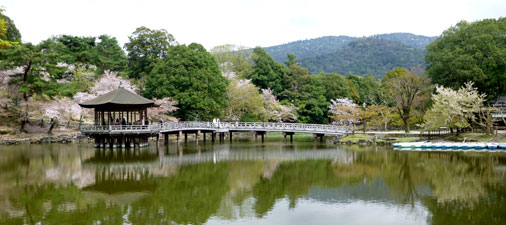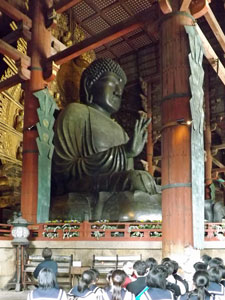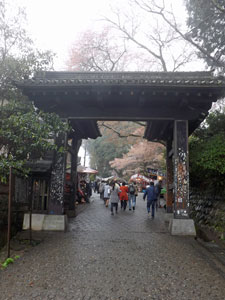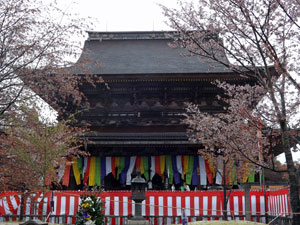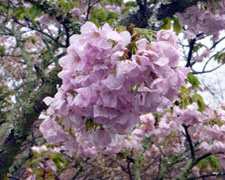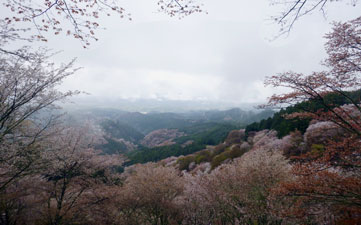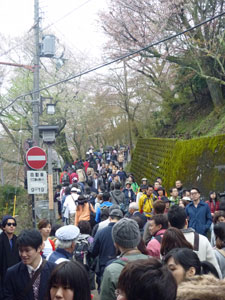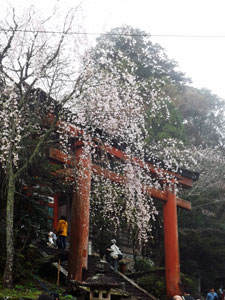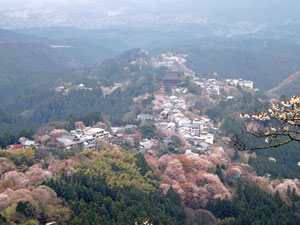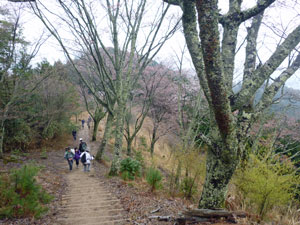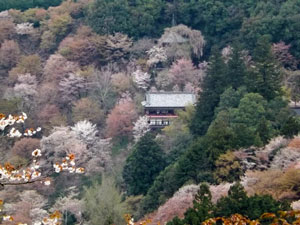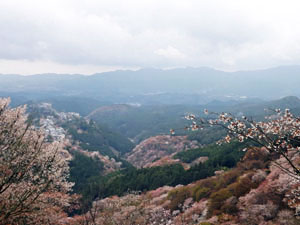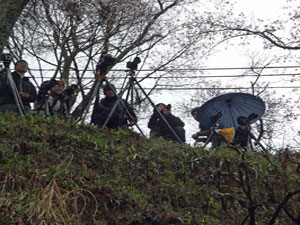| Walks in Nara and Yoshinoyama |
Nara |
It took a little more than an hour to get to Nara by train from Otsu. Consequently, we arrived late in the morning and left our bags at the ryokan where we were staying before setting off for a wander through Nara Park, the large open area to the east of the city. |
|
|
 Nara manhole cover |
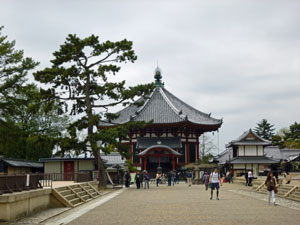 In the grounds of Kohfukuji Temple |
|
|
It was a pleasant stroll, as we passed through the grounds of the Kohfukuji Temple and its five-tiered pagoda and on to the shores of Ara-ike and Saga-Ike ponds. Here people were enjoying the hanami - picnics beneath the cherry blossoms - and recently married couples were having photos taken on the wooden bridge over Saga-ike. It was a chance to see the locals enjoying their beloved "sakura time".
From the ponds we wandered slowly up the central boulevard of the park towards Kasuga Taisha shrine and its many stone lanterns, past ancient trees in a closely-cropped grassy meadow. |
|
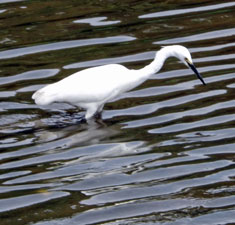 |
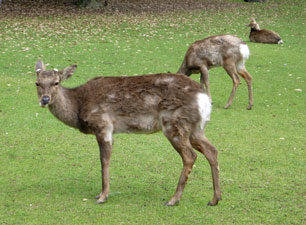 The deer of Nara Park |
|
The grass is kept cropped by the herds of deer for which Nara Park is famous - they are everywhere and are revered as messengers of the gods. The only messages that I saw them deliver were spread all over the grass - lie down at your peril. I like wild animals, but the deer here have become bludgers, constantly harassing tourists for food, a behaviour encouraged by many as "cute". Deer in Nara Park Leaving bad thoughts of deer behind, we turned north, passing some magnificent specimens of cherries in full bloom - most trees were now past it, making these specimens stand out even more. |
||
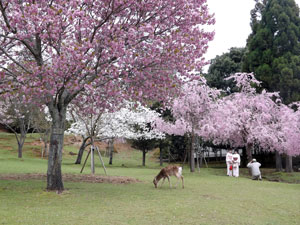 |
 Stone Lanterns of the Tasuga Kaisha Shrine |
 |
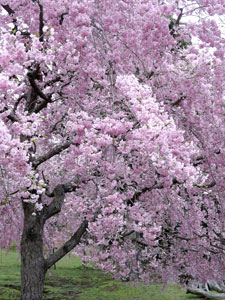 |
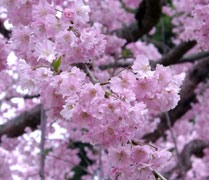 Photos of the spectacular cherry blossoms of Nara Park |
 |
Our perambulations took us to the Todaiji Temple, one of the most famous Japanese temples dating back to the 8th century. I now understood why the rest of the park seemed so quiet and peaceful - all the tourists were here, including bus loads of students out on school trips. |
Todaiji Temple has the largest wooden building in the world, the Daibutsuden (big buddha hall) whose last re-incarnation was built in 1692 after earlier fires. It needed to be large because the bronze statue of buddha inside is mind-bogglingly big. |
|
|
 Walled compound in Todaiji |
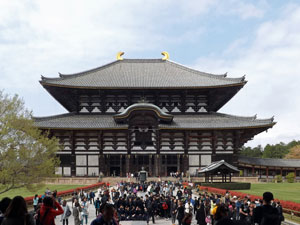 The Daibutsuden (largest all-wooden building in the world) |
|
|
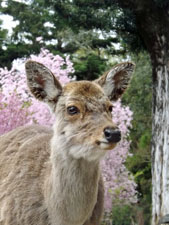 Portrait of a local resident |
 Nello contemplates the blossoms |
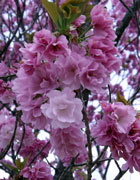 |
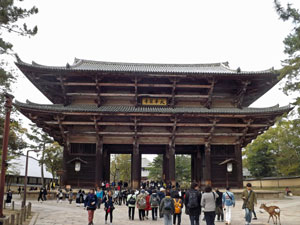 Gateway to Todaiji Temple |
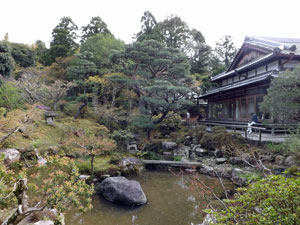 The tranquil gardens of Yoshikien |
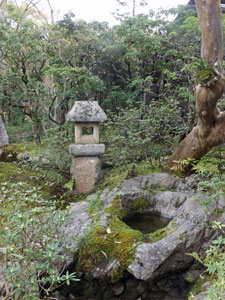 |
Leaving the temple via the large wooden gates, we visited the nearby Yoshikien Gardens for a bit of quiet time amongst the moss and water features and then called it a day. The forecast is not good - more rain is returning tomorrow, so we plan to have a layday and catch up with domestic chores. Then hopefully, the weather might clear for our next outing - a visit to Yoshino-yama, for centuries considered the no.1 cherry blossom spot by the Japanese themselves. |
||
|
The cherries of Yoshino-yama (10.5 km - 460m ascent - 460m descent) |
Trees tremble in wind Yoshinoyama is a mountain in the Kii Ranges almost two hours by train south of Nara. Over the centuries, more than 30,000 cherry trees of many varieties have been planted up the slopes of the mountain over an altitudinal range of 600m. Most were planted over the years as an act of devotion to the local gods. The differences in variety and in elevation ensure that somewhere on the mountain, cherries will be at peak bloom sometime during the month of April. As well, it has several temples and shrines (de rigeuer for famous places in this part of the world), and is an important site for the Shugendo sect, an ascetic form of mountain-worshipping buddhism. |
|
We wanted to get there ahead of the crowds, so an early start was required. Thus, we found ourselves on the 7am train out of Nara, bound for the village of Yoshino. We were becoming quite adept at the art of train-swapping and two changes and 90 minutes later we pulled in to Yoshino station at the base of the mountain. The rain had cleared, but the weather remained grey, with misty vapours entwining the ranges. |
|
 Mists drift over the mountains of Yoshino |
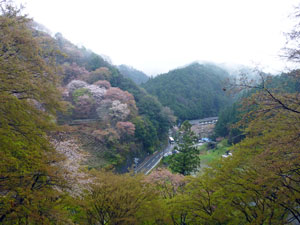 Climbing up to the village from the station |
|
It didn't take too long to realise that we would not be alone today, as several hundred people poured out of the train and headed for buses or the cable car to get up to Yoshino village (trains and buses would arrive steadily all day). A few, like us, headed up the winding road on foot - already we could see the famous cherries of Yoshino amongst the green-clad slopes of the surrounding hills. These were the plantings of the shimo-senbon, the lowest of the four cherry forests on the mountain. A couple of short-cuts up muddy steps brought us to the narrow streets of the village, lined with food stalls and gift shops. |
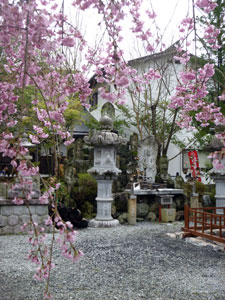 Blossom-strewn courtyard |
We joined the moving column of people and soon reached the Kinpusen-ji Temple, headquarters of the Shugendo sect of Buddhism and home to three blue-faced statues of Zaou Gongen, protector of the mountains. The fair Nello and I were feeling a bit "templed out", so we gave Zaou a miss and continued on up the hill. |
 Pagoda in Tonan-in Temple |
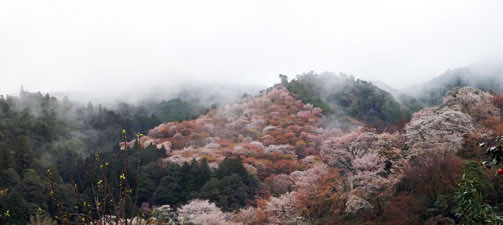 The misty blossom-clad hills of Yoshinoyama |
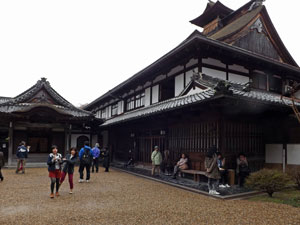 Chikurin-in Temple |
Climbing steeply up the road, we had almost reached the gates of Chikurin-in Temple when the sound of a conch bellowed out from the courtyard and a host of yellow-robed and black-clad people started appearing from within. We had stumbled upon the Zaou Dou Flower Festival Parade, an annual event where yakko (attendants), yamabushi (mountain priests), chigo (acolytes) and monks marched slowly to a strange beat, accompanied by conch and chanting, towards Kinpusen-ji to announce the flowering of the Holy Cherry Tree of Zaou. What a stroke of luck - this is our idea of a cultural experience. |
|||
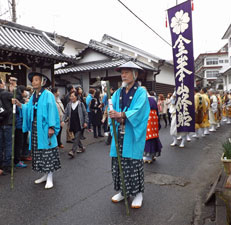 |
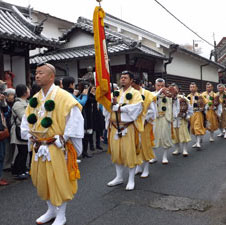 |
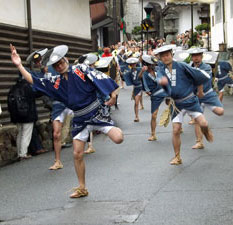 |
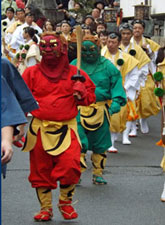 |
| Marchers in the Zaou Dou Flower Festival Parade | |||
|
Continuing the climb, we began to pass by the next groupings of cherry forests - the naka-sendon. The spectacle of these trees and those of kami-sendon plantings set amongst the misty hills and slopes was superb. This seemed to be the consensus view, as all along the route, people were stopping and taking terabytes worth of photos.
|
|
|
We continued our slow climb, stopping frequently to take in the expansive views of the pink haze of cherry blossom in the valley beneath, or stopping to check out the odd shrine that looked of interest, such as Mikumari-jinja. |
|
 |
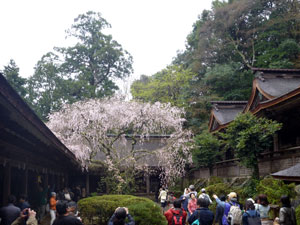 Courtyard of Mikumari Shrine |
|
Nearing the top, we passed through a section of dark, straight-trunked conifers (a bit of the original vegetation), before cresting the viewpoint on the summit of 852m Takagiyama. It was a good point to turn, and so we did, strolling slowly down as still more tourists puffed their way upwards, to gain a slightly different view of the magnificent cherries of Yoshinoyama. |
||
|
|
|
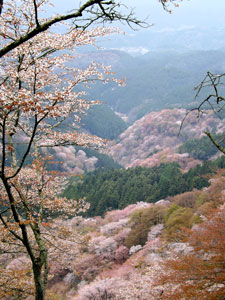 |
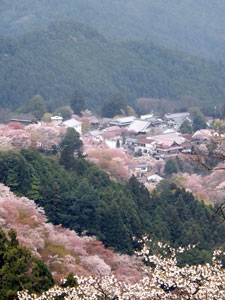 |
 |
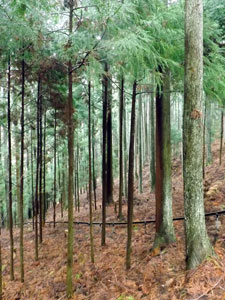 |
| The pink hazy vistas of cherry blossom mountain | Conifer forest near the summit of Takagiyama | ||
Interestingly, amongst the thousands of people, we only saw a couple of Caucasian faces - this hotspot of Japanese tourism is clearly off the radar of western tourists. It's a shame, really, as Yoshinoyama gives a very different perspective of cherry trees (and their blossoms) as part of a bigger landscape and not just bits of candy colour that brighten up a canal, park or temple. |
|||
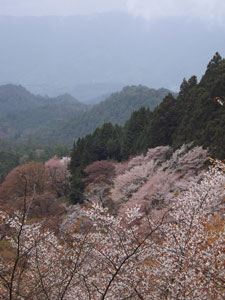 |
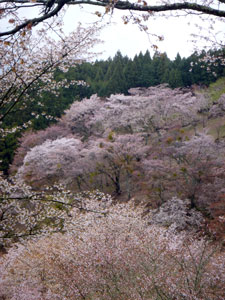 |
 |
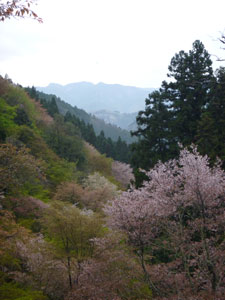 |
| Farewell to the cherry blossoms of Yoshinoyama | |||
As we headed down from the village, the wind shimmered the trees and petals fell down on us like soft pink snowflakes. It seemed an appropriate way to end our time of cherry-blossom in Japan. Finally, reaching the bottom together with a large part of the throng (by mid-afternoon, more were leaving than arriving) we boarded the train for a long standing-room only (for the first hour) slow ride back to Nara. It was tiring, but gave us a chance to more closely study one more interesting bit of culture - the Japanese art of train-sleeping. They do it so well! |
|||
|




